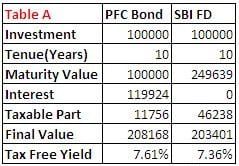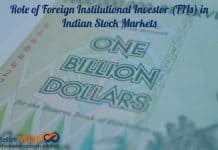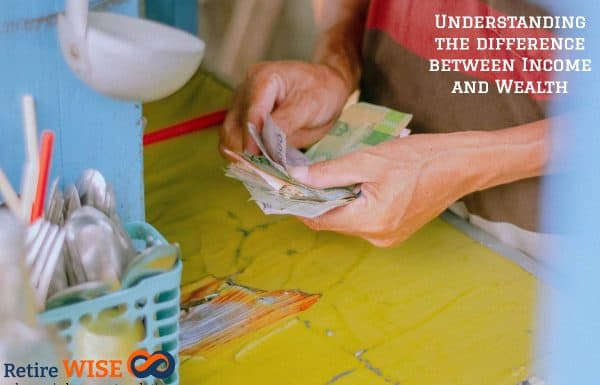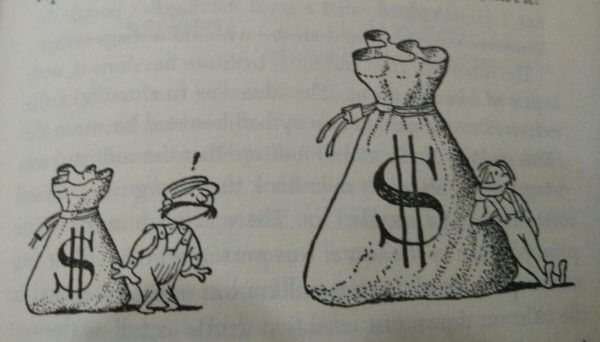NHAI & PFC have launched their tax free bonds, which would close for subscription on 16th Jan 2012. But looking at investors craze, it is expected that they will close earlier. Some other PSUs are in the queue with their offerings including HUDCO &India Railway Finance Corporation.

Can NRIs invest in tax free bonds?
Mails poured in with the subject “Should I invest in Tax Free Bonds?” and I replied with my favorite answer “DEPENDS”. But looking at the number of question, I have decided to share my view points.
They say “If you torture numbers enough, they will confess to almost anything” – so I will not torture numbers but will just ask three simple questions.
1. Are tax free bonds risk free?
For most of the people definition of risk is capital loss. So, in that case I believe there is not much risk as these are secured bonds from Public Sector Units. Even credit agencies like ICRA & Care have given their highest rating to NHAI & PFC issues. But what about other debt related risks:
Interest Rate Risk:There is negative relation between price of bond & interest rates – if interest rate will increase price of bond will go down & vice versa. This risk can be reduced if you hold bonds till maturity.
Liquidity Risk: Only way of exit from these bonds before maturity is selling them through stock exchange. If you have some bonds that you would like to sell for immediate requirement but there is no buyer or fewer buyers than sellers – you may have to sell your bonds at discount.
Reinvestment Risk: This is the biggest risk in these bonds. Prima facie it looks that these bonds are giving tax free 8.2% (10 year bonds) interest rate which should be equivalent to 11.87% taxable returns for someone who is in highest tax bracket. But important point her is these bonds are paying interest annually & not on cumulative basis – so you have to invest your coupons in some other investment at that point of time. Now this second instrument can be tax free or taxable with higher or lower interest rate. So reinvestment risk can have a major impact on your final yields.
2. Are tax free bonds better than SBI 10 year FD?
Every investment product should be compared with some similar product which can also have equal chances to be part of your portfolio. Here we are trying to compare SBI 10 year term deposit with PFC 10 year tax free bonds.
But first question is can we compare them at all? Not 100% as both the products have different features & risk. But still they can be compared if we assume that we are talking about a long term investor who will hold this product till maturity and SBI FD is as safe as these bonds.
SBI is giving 9.25% quarterly compounding on 10 year term deposits. If we convert quarterly compounding to yearly compounding, it turns to 9.58%. Now, I have Rs 2 lakh that I can invest for 10 years & I am in highest tax bracket. I distribute my money equally in Bank FD & PFC Tax Free Bonds.


So there is just a difference of .25% in highest bracket and is just opposite in case of Lower tax slabs. {Check Table B}
3. Are tax free bonds for wealth creation?
This is the last question but most important. Everyone should know purpose of his investment & if your purpose of investment is wealth creation, answer to above question is NO. Tax free bonds are for capital protection in best case scenario – in high inflation scenario even they will not be able to beat inflation. Tool for wealth creation is equity & according to current tax laws there is no long term capital gain tax on equity as well. For me it is really hard to think that equities will give less than 8.2% return in 10 years and 8.3% return in 15 years. Have we forgotten the basic rule – equity for long term & debt for short term.
So, does that mean one should not invest in these bonds? My answer is “it DEPENDS on your personal financial situation”. Do all permutation combination with your financial life and then take a cool headed final decision. Think Twice – Act Once.
I will love to hear your views in the comment section.
























I think we should not worry too much about compounding. If one wants to compound the money, he can always reinvest the interest every year and buy more bonds from exchange. Of course, you may not get bonds at Rs 5,000, but at a higher price. I have a crude plan now. Invest 12,00,000 in this for 15 years and get Rs 1,00,000 as interest every year. Invest this 1,00,000 in my daughter’s PPF account for 15 years – till maturity. This way I don’t have to search for money every year for PPF investment and also I can get the ‘compounding’ done.
Hi Bhushan,
Bond + PPF is a superb idea this is similar to people using interest of MIP in RD.
Bond + Equity (interest income going in equity mutual funds) can also work as capital protection fund with potential to generate higher returns. 🙂
The assumption here is rates on PPf will be stable for 15 years
Superb Bhushan!! I liked the idea of combining BONDS+PPF, as the big question for Bonds investors is, where to invest the annual interest without incurring tax on them. For this PPF is the best option wherein the compounding part is taken care and at the same time, you needn’t worry on the tax part as well.
Thanks for sharing your views. I think, you could also highlight that these bonds are ideal for planning retirement income.
Dear Vivek,
In 70-80% of the retirement cases (that I have come across) – people are in lower slabs. But definitely it make sense for someone who is in highest tax slab.
Hi Hemant,
In your first table – why is there a taxable part for PFC bond? Isn’t all of that tax free?
Hi Manshu,
First table is true for NHAI & PFC as rate is 8.2% for 10 years. I am not sure on what rate other issuers will offer their papers – as it depends on rate of Gilt.
Coming to your first question regarding taxable part:
“I may or may not get tax free options or even lower interest rates in future. So assuming that I will invest interest amount in some other instrument which can give me taxable return 8.2% CAGR till the maturity date of my 10 year PFC tax free bonds.”
Got it – thanks
Hi Hemant,
Thanks for the informative comparison. Complement you on the neat explanation. In your calculations for the returns from FD compounded quarterly, I presume tax deduction would happen every year end. Hence the net interest (net of tax deducted) would be less and hence reducing the total principal for following year. SBI quarterly compounding without 0 tax deduction would give a net return of 249556 (and as per IBA charts 249544.4). For a person in 30.9% tax bracket, this would get reduced to 189723 (assumption that tax deduction would happen in first quarter (March end), fifth quarter and so on in each of the 10 years).
Corresponding values for 20.6% tax slabs is 21o710 for 8.2% bond (with returns reinvested at taxable 8.2% ever year end, tax slab remaining unchanged) and 208036 for 9.25% quarterly deposit.
Corresponding values for 10.3% tax slabs is 215215 for 8.2% bond (with returns reinvested at taxable 8.2% ever year end, tax slab remaining unchanged) and 227938 for 9.25% quarterly deposit.
Thanks,
Harsha.
Hi Hemant,
Absolutely right. It does not make any sense in investing in these tax free options for long term basis. If I have Rs. 100000 to save for 10 years in order to save tax of Rs. 10000.. it is better for me to forget about Rs. 10000 and invest Rs.90000 in diversified equity funds which will get me more than Rs.208000 after 10 years.Especially when the ELSS is no more considered as tax saving option since next financial year.
Hemant, I have a question related to term plan as well which I have posted in the term plan article..Hope you have a look at it. 🙂
Hi Hemant, nice article.
Have a query regarding PFC bond – table A.
If 8200 is invested end of each year for 10 yrs, Future value is 119924.
119924 – (8200 x 10) = 37924
37924 x 30.9% = 11719
Final Value is 208205.
Is this calculation right ?
warm regards
Nipin
Hi Hemant,
Very nice article. I don’t understand why people forget to do their home work before making investment in this kind of tax saving bonds.
Still people are running after assured and tax free investment products forgetting inflation.
Time value of money is never taken into consideration.
Purchasing power of Rs.1,00,000 after 20 years will be Rs.6,72,7500.
We forget that investment done today is for future expenses. Only equity mutual funds (assuming 15%) can make that Rs.1lakh work harder to generate Rs.16,36,650.
Jagteraho!!!
Dear Hemant,
This is one more very impressive article. In fact today, I was planning to do the similar comparision as given in your table. I have just one comment: If senior citizen who is in 30.09% tax slab and comparing IDBI 10 year FD (10.25% for senior citizens), even if it is quarterly compounding and yearly tax deduction for bank FD, yeild for NHAI/PFC bonds and IDBI bank FD may be similar if Bond Interest reinvestment is in taxable instrument. Do you have any comments about this? Thanks for excellent info.
Never make an investment to save taxes. Investment mean generating money for future expenses and it can be done by investing equity mutual fund.
Hi Hemant
Thanks. This was an informative read.
Yes I agree, it depends. Especially though it may be considerd a strong view, I do not recommend investing in these bonds just for the purpose of saving tax. At the max, I can think of 2 categories of individuals who could go for it- people who are heavily invested in equities and need to make a portfolio reallocation towards debt, or 50+ who do not have much appetite to take risk.
Thanks again for the valuable post.
Abhinav
Its good and inormative
Dear Hemant,Really your article for tax free bonds is transperant and worth appreciating. If I consider for myself it is not worth investing for ten yrs.which is very long duration.Instead if you invest in FDs you have liquidity although there is interest loss. You can avail loan against bank fd but i dont think loan is available in this option.
THANKS FOR INFORMATION
DIPTI
For additional tax saving & 9 % interest on investment,I will defiantly recommended to invest Rs.20000 / Year.
Dilip
Great points raised Hemant. I would put my two cents for the other side of coin: why people are rushing in for these bonds.
1. There is volatility in the equity markets
2. Rate cut expectation in next 3-6 months with the interest rate at its peak,(tentatively)
3. AAA rated, tax free government backed paper giving a return of 8+% (though some have said pre-tax return of 11.7% for those taxed in the 30% bracket )
In the present scenario is seems a good option worth considering. And it also helps to do asset diversification.
But one needs to be careful of cons of the scheme which you have highlighted ex: Liquidity, reinvestment risk. Newspapers, Financial magazines, mail boxes or mobiles are bombarded with these offers. Infact a friend of mine who was out of station for last two days thought she cannot apply as bonds have been over subscribed. (Retail portion of the bond was not fully subscribed till yesterday )
Assuming one has a financial plan -Before one invests one needs to check if this option fits into the financial plan and then consider the option and see if it fits in.
But if one doesn’t then..I shall anecdote from “Alice in Wonderland” book
One day Alice came to a fork in the road and saw a Cheshire cat in a tree.
“Which road do I take? she asked.
Where do you want to go? was his response. I don’t know, Alice answered.
Then, said the cat, it doesn’t matter.”
Muthoot Finance current NCD’s are also available for 2 years @ 13% Interest p.a.
I think this is a good option to invest for 2 years. It had fairly decent ratings too.
It may not go bankrupt in 2 years. I have invested some money in it.
Rakesh
Hi Hemant
A very useful post. I read your thoughts on Onemint and liked this-
Budget is the “”numero uno”” step of financial planning & it is also the only panacea for good financial health. With technological enhancements, every day it we face new ways to spend our money without realizing its long term impact.
When you don’t have budget everything looks important & necessary. Biggest problem of not having budget means you are likely suffering a financial disease called “”I NEED IT NOW””. It looks so good so… I NEED IT NOW, there is good discount so… I NEED IT NOW, my friend bought it & I am suffering without it so…. I NEED IT NOW & the story continues. Are you a kid?? Remember the most insane reasons we gave to our parents just to own a stupid looking toy. Don’t feel guilty you still have time to improve it. Just do it!!”
I was waiting for your New Year Resolutions. Here I share my thoughts.
I will try to conquer my worst impulses to save my financial future.
I will try to recognize the potential danger in every investment decision I make.
Some thoughts for the readers.
– Do not constantly judge your own success by that of others.
– Do not resent the success of others when your own investments falter.
– Do not refuse to accept help or advice from others.
– Do not think that you alone know what is the best investment.
– Do not make investments based purely on media hype or industry buzz.
– Be guided in your investment decisions by common sense and cold hard numbers.
– Do not hold on to your investments long after their expiry date.
– Do not be frustrated by short term changes in the market.
– Do not sacrifice the long term growth for the quick hit.
– Do not gobble up every investment instrument in sight without caring about your financial health.
– Do not ignore your financial future.
Hi Anil,
Your tips are awesome & I expect an article around them.:)
What is your view for those retired people, who are in highest tax bracket but need money for regular consumption and for that depend on interest income from deposits/securities?
Hi Anil,
Taxation plays a key role in earning the right amount of income. For highest tax bracket individuals, choosing the right options is very important.
There is hardly any instrument which gives you higher post tax fixed returns. You can lower taxability by choosing a mix of fixed and variable options. Mutual Funds have options in debt investments where you can earn a good regular income.These are highly tax efficient then traditional deposits/securities.Although the income will be variable, but there are schemes where you will find consistency.
Comments are closed.